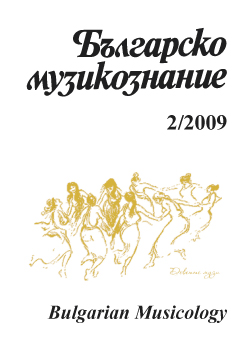Теория и праксис – литургия и музика – традиция и съвременност
Theory and Praxis - Liturgy and Music - Tradition and Contemporaneity
Author(s): Ivan IvanovSubject(s): Music
Published by: Институт за изследване на изкуствата, Българска академия на науките
Summary/Abstract: In the text are explained problems relevant to the place of sacred music and especially the church chanting, in the cultural and social outlook of contemporaneity, indicating several essential points on which my study was built upon. In the process of clarifying the place and the role of church music in faithful education, were examined basic theoretical and methodological problems. The formation of musical characters in men appears also as a basic foundation in music creation. That is why the cult, as main way of external manifestation of worshiping God and religious feeling in general, leads to the necessity of expressing feelings/ emotions and the easier way to achieve that is through the language of music. The music is a way to manifest the cult in its visible forms – canon law, symbol, sacrament and sacrifice. The question of what the process of going back to the beginning, to the archetypes and the ancient principles of tradition means, is brought up. The church composers, according to the requirements of ecumenical council for following the archetype (repeatedly called tradition), strictly kept an eye on the performance and the interpretation of sacred music. In the earlier period of Christian liturgy’s formation was necessary that on the chants, as enigmatic creations of true faith, were imposed requirements (with dogmatic character) of how to be composed, in contrast to the heretic songs, nearest to the human sensuousness. Thus, a connection could be established between the archetypes of the wordless (angelic) singing and the composed afterwards a humane cult music, as a creation. To resemble the archetype (the angelic chanting), the prototype was preserved, in other words the concrete musical outcome. When Saint Vasilii (Basil) the Great talks in his Anaphora about the angelic chants, he uses the term divinity (θεολογίαις) or theology, in contrast to humanely doxology (δοχολογια, ν), which is also mentioned in the text. In the music tractates (in an indirect way) is required a proper conduct and an angelic-like interpretation of the hymnody and the music texts from the singers. Namely, the music prototype is the place where the theological and scholar interpretations of medieval music, harshly walk past each other. The examined research problems here in are: church music as theory; symbol and church music; church music as praxis and its place in the Liturgy; tradition and church music; and Byzantine chant practice. The question of church music and modern time challenges, is still debatable. A mutual collaboration is needed to preserve the religious inheritance, not only on words and on the pages of school-books, on meetings and conferences, in schools and medias, but also there where you call your Savior, where others are going to see, where the custodians of the tradition (ecclesiastics and/ or researchers), won’t obey the accumulated prejudices and xenophobia, but contribute to the self-identifi cation of each individual...
Journal: Българско музикознание
- Issue Year: 2009
- Issue No: 2
- Page Range: 42-64
- Page Count: 23
- Language: Bulgarian
- Content File-PDF

